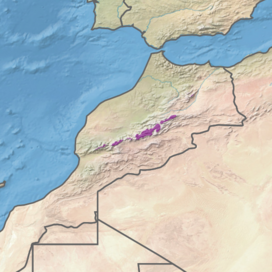Mediterranean High Atlas juniper steppe
| Mediterranean High Atlas juniper steppe | |
|---|---|
 | |
 Map of the ecoregion | |
| Ecology | |
| Realm | Palearctic |
| Biome | montane grasslands and shrublands |
| Borders | |
| Geography | |
| Area | 6,328 km2 (2,443 sq mi) |
| Country | Morocco |
| Conservation | |
| Conservation status | Vulnerable[1] |
| Protected | 1,682 km2 (27%)[2] |
The Mediterranean High Atlas juniper steppe is a montane grasslands and shrublands ecoregion in Morocco. It extends along the High Atlas range of northwestern Africa's Atlas Mountains.
Geography
The ecoregion extends from 2700 meters elevation up to 4167 meters elevation on Toubkal, which is the highest peak in North Africa.[3]
Climate
The ecoregion has a temperate montane climate. Average annual precipitation varies from 200 to 600 mm, and up to 1000 mm in the wettest areas. North-facing slopes are generally cooler and more humid, and snows can persist as long as seven months above 3500 meters elevation. South-facing slopes are generally more arid, and are exposed to drying winds from the Sahara.[3]
Flora
Open woodlands of juniper (Juniperus thurifera) and evergreen holm oak (Quercus rotundifolia) are the characteristic plant community, extending up to the treeline at approximately 3200 meters. The critically endangered Moroccan cypress (Cupressus atlantica) has been reduced to a few hundred trees scattered in the western portion of the range. Thorny and cushion shrubs cover the ground, including Cytisus balansae, Erinacea anthylis, Prunus prostrata, and Astragalus armatus.[3]
Denser stands of oaks and junipers have an understory of shade-loving shrubs including

Open grasslands cover ridgelines, and extend from the treeline to the summits, interspersed with areas of bare rock. These high meadows are adapted to strong winds and alpine conditions, and include Avena montana, Festuca mairei, Festuca alpina, and Ranunculus geraniifolius.[3]
At lower elevations, the juniper and oak woodlands transition to evergreen broadleaf forests, which extend up to 2800 meters elevation on humid north-facing slopes, and xeric conifer forests extend from 1500 meters elevation up to 3100 meters on drier south-facing slopes.[3]
Fauna
The High Atlas is home to the
Native birds include the
Reptiles endemic to the High Atlas include the Atlas day gecko (Quedenfeldtia trachyblepharus), Quedenfeldtia moerens, Atlas dwarf lizard (Lacerta andreanskyi), Atlas mountain skink (Chalcides montanus), and Atlas mountain viper (Vipera monticola).[3]
Protected areas
Protected areas include Toubkal National Park and Haut Atlas Oriental National Park.
References
- ^ "Mediterranean High Atlas juniper steppe". Terrestrial Ecoregions. World Wildlife Fund.
- PMID 28608869.) Supplemental material 2 table S1b.
{{cite journal}}: CS1 maint: date and year (link - ^ a b c d e f g h i Burgess, Neil, Jennifer D’Amico Hales, Emma Underwood (2004). Terrestrial Ecoregions of Africa and Madagascar: A Conservation Assessment. Island Press, Washington DC.
- ^ BirdLife International (2020) Important Bird Areas factsheet: Parc National de Toubkal. Downloaded from http://www.birdlife.org on 28/10/2020.
